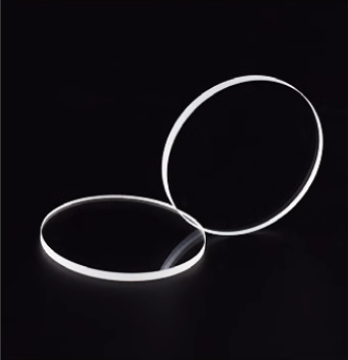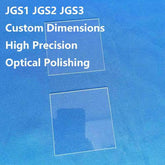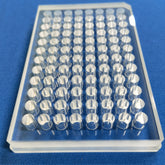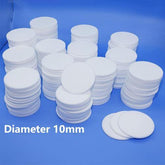High transparency and transmittance of sapphire glass windows
Sapphire glass windows are characterized by their high transparency and transmittance properties, which are a result of the high quality and purity of the material itself. This feature provides stability and durability in the environment, as well as making them suitable for a variety of high-end applications.
1.Physical characteristics of sapphire glass windows
Sapphire is a mineral composed primarily of alumina (Al2O3), whose crystal structure is closely arranged and chemical properties are stable, resulting in excellent physical properties. Among the notable characteristics of sapphire is its high transparency and transmittance. This property is primarily attributable to the minimal presence of impurities within the sapphire material, the reduced number of crystal defects, and the ability of light to mitigate scattering and absorption during its transmission through the sapphire, thereby facilitating efficient transmission.

The high transparency of the sapphire glass window enables the transmission of light through the material with minimal impediment, thereby preserving the intensity and directionality of the light. This property is paramount for applications that necessitate the precise control of light propagation. The high transmittance of the sapphire window ensures that specific wavelengths or bands of light can pass efficiently, according to the design requirements, to meet a variety of complex optical requirements.
2.Manufacturing techniques of sapphire glass windows
In order to achieve the requisite levels of transparency and transmittance in sapphire windows, it is essential to use advanced manufacturing processes and technologies. Presently, the Kyropoulos method (KY method) is a high-precision crystal growth technology that is widely utilized in the industry for the preparation of sapphire crystals. Through the precise control of environmental factors, including temperature, pressure, atmosphere, and other conditions, these technologies facilitate the gradual crystallization of the alumina raw materials in the molten state, resulting in the formation of large-size, high-quality single crystal sapphire.
 Following the completion of the crystal growth process, subsequent processing procedures, including fine cutting and polishing, are imperative to ensure that the optical surface of the sapphire window attains a high degree of smoothness and finish. These processing processes require not only sophisticated equipment and complex processes, but also the operator to possess extensive experience and expertise in order to reduce the incidence of scratches and defects during processing and to guarantee the optical performance of the sapphire window.
Following the completion of the crystal growth process, subsequent processing procedures, including fine cutting and polishing, are imperative to ensure that the optical surface of the sapphire window attains a high degree of smoothness and finish. These processing processes require not only sophisticated equipment and complex processes, but also the operator to possess extensive experience and expertise in order to reduce the incidence of scratches and defects during processing and to guarantee the optical performance of the sapphire window.
3. Extensive applications of sapphire glass windows
Sapphire windows have been extensively utilized across a multitude of fields due to their exceptional transparency and transmittance properties. In the domain of optics, the material is utilized as a window component for lasers, optical sensors, infrared detectors and other devices. It effectively mitigates the interference of the external environment on the internal optical components of the device, while ensuring the efficient transmission of optical signals. In the aerospace sector, sapphire window has been extensively utilized in a variety of applications due to its high temperature resistance, radiation resistance and other characteristics. It is a common material in aircraft, satellites and other spacecraft portholes and observation windows, ensuring that astronauts are provided with a clear and safe vision.

Furthermore, sapphire windows are extensively utilized in semiconductor manufacturing, biomedical, and chemical industries, among others. In the field of semiconductor manufacturing, sapphire is utilized as the substrate material for LED chips. The high transparency and transmittance of sapphire facilitate enhanced light efficiency and stability in LED devices. In the biomedical field, the material finds application in the fabrication of endoscope lenses and other medical instruments, thus meeting the requirements of high-precision and high-definition surgery. In the chemical field, due to its corrosion and wear resistance, along with other characteristics, it is utilized as an observation window for reactors, pipelines and other equipment.
Sapphire windows boast high transparency and transmittance characteristics, rendering them highly applicable in scientific, technological and industrial contexts. In light of the growing global emphasis on environmental protection and sustainable development, along with the emergence of green manufacturing and recycling as key industry priorities, sapphire windows are poised to play a significant role in these areas. In order to promote the green and sustainable development of the sapphire industry, it is essential to optimize the production process, reduce energy consumption and emissions, and improve the recycling rate of materials.






